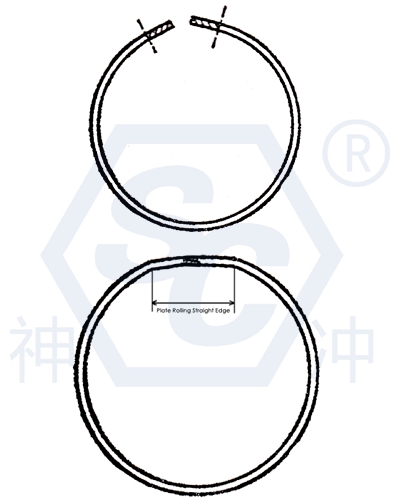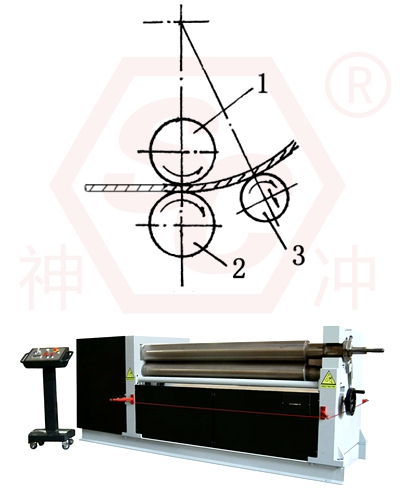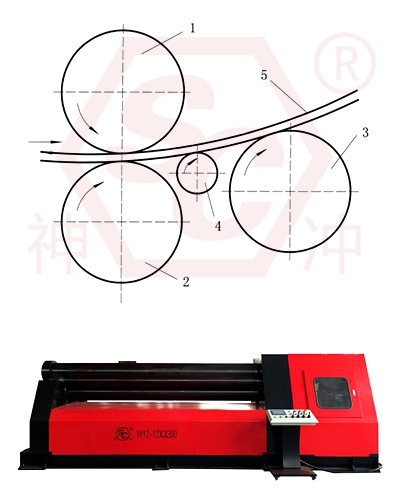
When the sheet metal rolled on a rounding machine, there are always remaining straight edges at both ends. So how is the straight edge of a curled circle formed? What problems will it cause? How to solve and deal with the problem of plate rolling straight edges?

The cylinder body rounding process in steel cylinder production is mostly carried out by a three roll plate rolling machine in most enterprises. However, the 3-roll plate rolling machine has a structural flaw, which is that there will be a straight section at the beginning and end of the plate rolling, commonly known as a straight edge.
For a typical three roller plate bending machine, the larger the cylinder diameter, the wider the straight edge. When producing standard 200L steel drums, the width of the straight edge can reach 50-100mm, which will vary with the diameter of the rollers in the rounding machine.

The reason for the appearance of straight edges at both ends of the coil is that there is a certain distance between the feeding roller and the forming roller of the three roll edge rolling machine. This distance causes a distance of roll off at both the beginning and end of the sheet metal, which prevents this section from being limited by the bending force of the rollers. The distance between the straight edge section is exactly the distance between the feeding roller and the forming roller.
After the cylinder body produces a straight edge, after seam welding and welding, the weld seam and the straight edge on both sides of the weld seam will still exist. For the cylindricity of the entire cylinder, this section is a straight surface, causing the cylinder to lose its roundness. The curvature on both sides of the weld seam is infinitely large, resulting in the inward depression of the cylinder body. The diameter of the cylinder body here is slightly smaller than other positions. Generally, it should be about 5-10mm smaller than the standard cylinder diameter.
For cylindrical workpieces, straight edge segments may affect the overall appearance quality.
Generally speaking, for standard steel drums, flipping, corrugation, and ring reinforcement are performed on the cylinder body. Through this series of processing, the cylindricity of the cylinder body will be corrected, and the straight edges at both ends of the coil will also be eliminated. So, the appearance of standard steel drums will not be greatly affected by straight edge issues.
However, for non-standard steel drums, especially those without ripple and ring reinforcement on the cylinder body, the straight edges at the weld seam will not be corrected.
For such steel drums, the plate rolling straight edge at the weld seam not only affects the overall appearance quality of the drum, but more importantly, directly affects the normal use of the user.
Most users of silicone products are filled with liquid when they inject the product into the bucket. But when the product reaches room temperature after being packaged, it becomes a viscous substance. When users want to take out the product, they usually use a pressure plate to extend into the cylinder and squeeze it inward to squeeze the product out of the cylinder. The size of its pressure plate is slightly smaller than the standard inner diameter of the cylinder (about 1-2mm). When the straight edge of the weld seam is too large, the diameter here will be smaller than the diameter of the extrusion disc, causing the extrusion disc to not be able to extend into the cylinder for extrusion operation. In this case, it affects the user's use and creates serious quality issues.
When the extrusion disc is pressed into the steel cylinder, if there is a straight edge at the weld seam, the cylinder body will be concave towards the cylinder, and the edge of the extrusion disc will generate friction with the weld seam. Steel drums containing silicone products generally have an inner coating. When friction occurs between the extruded disc and the weld seam, the inner coating at the weld seam will be scraped off, contaminating the goods.
Many users repeatedly use steel drums to transport goods, and when using them for the second time, the inner coating powder scraped into the drum during the first extrusion can also contaminate the goods for the second shipment. Some users have found that the silicone products in the bucket are contaminated by powder impurities, which is the reason.
So, the problem of the cylinder body curling with straight edges can sometimes be fatal.
There are many solutions to the problem of curling straight edges both domestically and internationally. Here, we will explore some practical production plans.
A regular plate rolling machine is a 3 roller plate bending machine, which produces a straight edge section length equal to the distance between the feeding roller and the forming roller, and needs to process cylindrical workpieces with standard diameters. This distance cannot be reduced. The reduction of distance means the reduction of cylinder diameter size.

So we need to use SC four roller plate rolling machine, which means adding a correction roller between the feeding roller and the forming roller. When the material head comes off the roller, this correction roller comes into effect, which can continue to maintain the forming force and effectively reduce the length of the rolling straight edge section.
The use of correction rollers greatly reduces the length of straight edges. However, due to the distance between the feeding roller and the correction roller, the straight edge segment cannot be completely eliminated. However, for standard steel drums, this small straight edge segment can be basically ignored. But for steel drums with special requirements, they may not meet the requirements yet.
There is also a fully automatic seam welding machine that uses a correction plate for correction, which is a circular arc track set between the feeding roller and the forming roller. When the material head enters and disengages the forming roller during plate rolling, the correction plate continues to complete the round rolling work. This type of mechanism has a better correction effect and a smaller length of straight edges compared to the four roll bending machine. Basically able to meet the cylindricity requirements of various barrels.
Most effective solutions for curling straight edges both domestically and internationally use pre bending methods. Before the steel drum is rolled, pre bend the two ends. The press brake machine can be used to pre bend the rolled sheet material. It is also possible to use a regular press and install a pre bending mold.
Although this method is effective and the process is not complicated, its production efficiency is not high and it is not very suitable for the requirements of large-scale production.
After welding the cylinder, using an expansion machine to correct the cylindricity of the cylinder is a practical method for barrel making enterprises. This method can be modified from a regular cylinder ring reinforcement expansion machine. Set the expansion mold to a cylinder with the same diameter as the cylinder.
In general, due to the rebound effect of the steel plate, the degree of expansion should be slightly greater than the standard diameter of the steel barrel to ensure that the cylinder's cylindricity is corrected. The specific expansion parameters require careful design and experimentation to determine.
This supplementary method, if the expansion is too large, is likely to use a cylinder diameter that exceeds the standard, causing other quality problems. If the degree of expansion is insufficient, it is likely that the plate rolling straight edge will not be well eliminated.
In addition, after the expansion mold expands, there is a certain gap between the cylinder expansion block and the expansion block, which, due to the lack of module support, will generate a straight section between the gaps. If there are a large number of rising blocks, the impact of this straight edge segment is not significant. But if the number of rising blocks is small, the straight edge segment may be too long. Not only does it fail to achieve the goal of cylindricity compensation, but it also exacerbates the problem of straight edges.
The end rolling bending machine is a processing method that separates two pairs of rollers arranged along the length of the cylinder plate, allowing the two ends of the plate to pass through and be bent. To make the two pairs of rollers fit the length of the sheet metal, the method of changing the spacing between the frames can be used.
The above introduces four solutions to the problem of straight edges in cylindrical coils. Each has its own characteristics and advantages and disadvantages. The specific plan to be adopted should be selected according to the production situation of the enterprise itself.
If the user does not have high requirements for the cylindricity of the steel drum, but the ordinary three roll plate rolling machine cannot meet the requirements, a four roll plate rolling machine with correction rollers can be used for correction to reduce the length of the straight edge.
The method is simple, easy to implement, and the investment is not significant. But if we want to completely eliminate straight edges, this plan is not suitable.
For situations where the requirements for straight edges are not high, an expansion machine can also be used for correction and correction. Because this correction has material rebound factors, although it can improve cylindricity, it is not easy to complete the correction and eliminate plate rolling straight edges.
If the production variety is small batch production and does not require high production efficiency, a press brake machine can be used for pre-bending.
If it is a large-scale production of single diameter steel drums, it is recommended to add an end rolling and bending machine equipment on the production line.